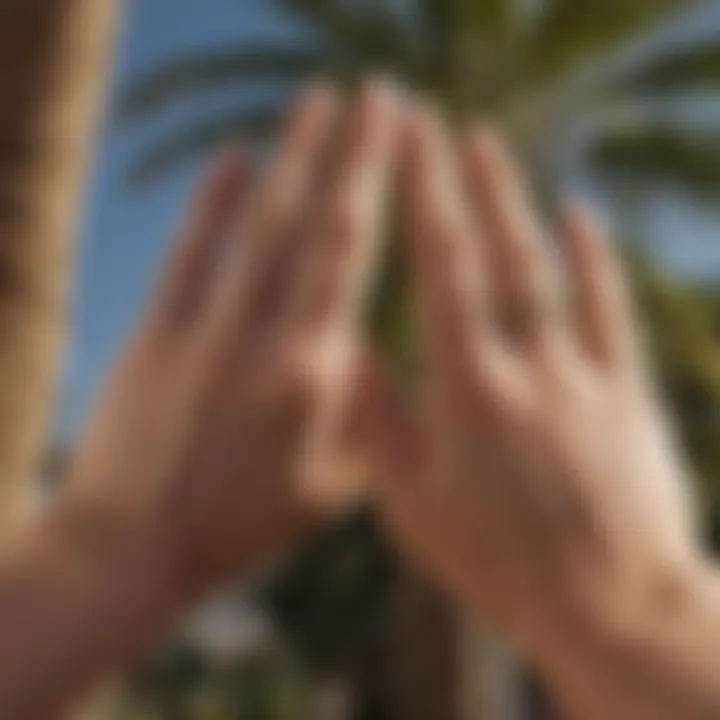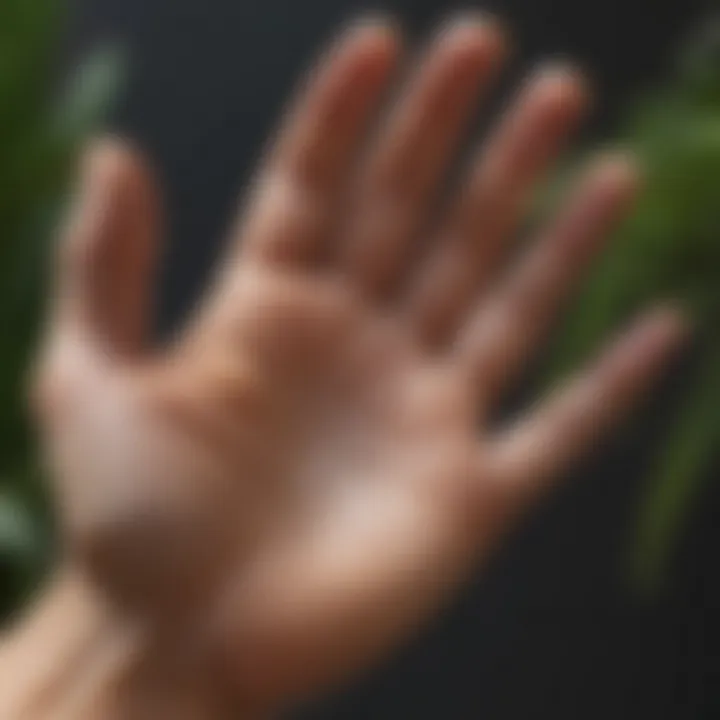Discovering What Your Palms Say About You


Intro
Palmistry, the intricate art of interpreting the features found in one's palms, has captivated humanity for centuries. This ancient practice, thought to trace back to diverse cultures, delves into the confluence of physical traits and inner consciousness. As you gaze upon your palms, you’ll find not just the lines and mounts but a roadmap to understanding yourself. It's as if your hands carry whispers of your destiny, waiting to be deciphered by keen eyes.
Understanding palmistry involves far more than merely reading lines. It's about connecting the dots between what you see and who you are. This exploration will take us through the significant elements of palmistry, facilitating a revelation of your personality traits, emotional dynamics, and life’s journey. The linchpin here lies in observing the patterns of your palms—your heart line, head line, and life line—while considering the shapes and dimensions that form the unique topography of your hands.
Let's set the stage by embedding palmistry in a broader astrological context, as the two fields complement and enrich each other. The palm reveals aspects of you that astrology also seeks to unveil, forming a bridge connecting the physical realm to deeper metaphysical inquiries.
Now, we embark on this journey to unveil the secrets held within your palms, guiding you toward enhanced self-awareness and insights that resonate on both personal and cosmic levels.
Understanding the Zodiac
Overview of Zodiac Signs
Before diving deeper into the fascinating world of palmistry, it’s worth noting that astrology, another complementary art, plays a crucial role in understanding ourselves. Zodiac signs, based on twelve divisions of the celestial sphere, symbolize distinct personality traits and characteristics. Each sign comes with its own set of strengths and weaknesses.
- Aries: Bold and adventurous
- Taurus: Practical and reliable
- Gemini: Curious and adaptable
- Cancer: Nurturing and empathetic
- Leo: Charismatic and confident
- Virgo: Detail-oriented and analytical
- Libra: Harmonious and diplomatic
- Scorpio: Intense and transformative
- Sagittarius: Optimistic and free-spirited
- Capricorn: Disciplined and ambitious
- Aquarius: Innovative and humanitarian
- Pisces: Intuitive and artistic
Sign Traits and Characteristics
Each sign not only provides a glimpse into personality but also offers clues about your life strategies, emotional responses, and relational dynamics. Whenever you engage in palmistry, remember how your zodiac sign intertwines with your hand structure. For instance, a Leo might demonstrate more assertive lines, signifying their natural leadership, whereas a sensitive Pisces may reflect softer, curved lines.
Elemental Qualities
Zodiac signs also align with the four elements: Fire, Earth, Air, and Water. These elemental qualities add depth to one's personality:
- Fire signs: Embody energy and passion; they may have prominent heart lines that reflect their intense emotions.
- Earth signs: Grounded and practical; their life lines are typically strong and defined.
- Air signs: Intellectual and communicative; you might observe distinct head lines that reflect their thought patterns.
- Water signs: Reflective and emotional; the heart lines are often intricate, hinting at complex inner worlds.
When blending these astrological insights with palmistry, you create a comprehensive profile that enhances personal understanding.
"The hand is a microcosm of the soul, translating the essence of who we are into a language of lines and shapes."
As we traverse the realms of palmistry, keep these zodiac frameworks in mind. They may unlock further layers of meaning within your palms, ultimately leading you toward a clearer understanding of your unique path.
Astrological Insights
Current Astrological Trends
The astrological landscape continuously ebbs and flows, impacting not only your energies but also the insight gained from your palms. Understanding current astrological trends can enhance your readings. The cycles of planets, especially Mars and Venus, can influence how one interprets love and ambition in both palmistry and astrology.
Influence of Celestial Events
Celestial events such as eclipses, retrogrades, and full moons often serve as significant markers in one's life journey. These events may disturb or illuminate certain palm features, signifying shifts or transformations, reminding us that we are part of something larger.
How to Interpret Your Birth Chart
An astrological birth chart can provide context to your palmistry findings. Every individual has a chart based on the exact moment of their birth, filled with unique positions of planets that correspond with different aspects of your life and nature. Integrating this with what you find in your palms can create a dynamic narrative of who you are.
Horoscope and Predictions
Monthly or Weekly Forecasts
Writing astrological forecasts provides guidance and lays groundwork for incorporating palmistry into your daily practices. Understanding where your palm lines align with current celestial influences can enhance your decision-making abilities.
Personalized Horoscope Reading
Personalized horoscope readings foster deeper introspection by correlating one's palm features with their astrological signs, resulting in tailored advice and meaningful insights.
Compatibility Readings based on Zodiac signs
Compatibility analysis based on zodiac signs can be insightful, particularly when considering relationships alongside palmistry reading. The nuances of both realms can reveal deeper connections or potential friction in any given partnership.
In weaving together astrology with palmistry, we foster a rich tapestry of personal discovery that resonates uniquely with each individual. By acknowledging the interplay between the two, we are well-positioned to extract profound insights not only from our palms but from our overall experience in this world.
Foreword to Palmistry
Palmistry, often referred to as chiromancy, is an intricate art that extends beyond mere entertainment. It digs deep into the human experience, offering insights into one’s character and life journey. In this section, we start laying the groundwork for understanding why palmistry matters, especially today when many are in pursuit of self-awareness and personal growth.
Defining Palmistry
Palmistry is the practice of interpreting the lines, shapes, and features found on an individual's palms. Think of it as a language that speaks volumes about a person’s temperament, emotions, and potential future. Each palm has unique characteristics that tell a different story, much like the fingerprints that set us apart.


Some commonly discussed elements in palmistry include:
- The Lines: Each line on the palm—such as the heart line, head line, life line, and fate line—provides clues about emotional facets, intellect, life experiences, and even career paths.
- The Shape of the Palm: The overall shape can indicate elemental characteristics. For example, a square palm might denote practical and down-to-earth qualities, whereas a long palm could suggest creativity and intuition.
- The Mounts: These are fleshy areas on the palm associated with different planetary influences, revealing traits connected to Venus' love or Saturn's seriousness.
Understanding palmistry allows individuals to tap into their innermost selves and reflect on personal journeys, making it particularly valuable for those seeking clarity.
Historical Background
Palmistry's roots stretch back thousands of years. Historical texts suggest that its origins may trace back to ancient India, where it was intertwined with astrology and spiritual practices. From there, it traveled westward, gaining prominence in the realms of ancient Greece and Rome, eventually making its way to the Western world.
Throughout history, different cultures have embraced and interpreted palmistry in unique ways:
- In ancient Greece, philosophers like Aristotle and Hippocrates offered insights into the significance of palm lines, linking them to psychological profiles and health.
- Medieval Europe saw a resurgence in palmistry, where it was often utilized by fortune tellers, shaping how people perceived their futures and destinies.
- In modern times, palmistry has evolved further, melding scientific exploration with metaphysical inquiry, influencing various esoteric practices.
"Our palms are a map of our lives, reflecting the paths we have taken and the journeys yet to come."
Understanding the historical context of palmistry not only enriches its practice but also sheds light on its continuing relevance. In a world constantly seeking meaning, palmistry serves as a bridge between the past and the present, inviting us all to delve into its depths.
Understanding Palm Lines
In the realm of palmistry, palm lines serve as the essential building blocks for understanding the intricate narratives we carry within our hands. These lines are not mere markings; they embody a complex interplay of our experiences, emotions, and character traits. Recognizing this dimension can unlock a treasure trove of self-awareness, guiding individuals down a path of personal growth and introspection. Indeed, the lines on your palm can act as a map to your inner world, revealing tendencies, challenges, and potential.
The Heart Line
The Heart Line crosses the upper part of the palm. Its shape and length can tell a story about emotional depth, romantic inclinations, and interpersonal relationships. A long and curvy Heart Line often suggests a person with deep emotional connections and a pronounced capacity for empathy. Conversely, if this line is short or straight, it may indicate a more pragmatic approach to love and relationships. The forks or breaks in this line might reflect past emotional challenges; hence, they become touchpoints for reflection and healing.
The Head Line
Next, we examine the Head Line, which governs intelligence, decision-making, and thought processes. Found just below the Heart Line, its principles are fascinating. A long and clear Head Line frequently denotes analytical skills, a methodical mindset, and a propensity for introspection. On the other hand, a wavy or broken line can indicate a more spontaneous or creative thinker, perhaps someone who follows their instincts more than logic. This line is integral for understanding how we approach problems and whether our strategies are reflective of thoughtful reasoning or impulsive choices.
The Life Line
Shifting gears, we find the Life Line that arcs around the base of the thumb. This line, often mistaken for a measure of one's longevity, actually captures vitality and major life changes. A strong, deep line can symbolize passion and fullness, while a faint line might suggest a more laid-back approach to life's challenges. The presence of breaks or forks in the Life Line often signifies notable transitions, reflecting changes in lifestyle, health, or significant events. Importantly, it indicates quality over quantity regarding life experiences.
The Fate Line
Lastly, the Fate Line, however, is a wildcard in palmistry. It shines light on one’s destiny, career choices, and life path. Not everyone has a clearly defined Fate Line, and its absence does not hint at an aimless existence. Instead, it may correlate with a life led by personal decisions rather than external influences. For those with a prominent line, its clarity and depth can offer insight into one's sense of purpose and motivation found in their work and responsibilities. Disruptions along this line could suggest shifts in life direction or shifts in career paths.
"Palm lines are not fixed; they shift and change over time, much like our lives."
The Shape of Your Palm
Understanding the shape of one’s palm is pivotal in palmistry as it unveils insights that contribute significantly to comprehending an individual’s character and personality traits. The shape acts as a canvas upon which various attributes are painted, offering a glimpse into how a person interacts with the world around them. Different palm shapes resonate with elemental qualities that can guide self-reflection and even personal growth. Therefore, recognizing these traits may assist practitioners in understanding themselves or those they read for with more clarity.
Elemental Shapes
In the realm of palmistry, there are predominantly four elemental shapes classified—Earth, Air, Fire, and Water. Each shape correlates to a unique set of attributes, providing a coherent narrative around someone's approach to life. Let’s break these down:
- Earth (Square-shaped palms): Individuals with this palm shape are often grounded and practical. They exhibit a tendency towards reliability and stability, favoring a structured way of life.
- Air (Rectangular palms): These folks are characterized by intellectual pursuits and creativity. They enjoy thinking outside the box and often find themselves experimenting with new thoughts and ideas.
- Fire (Square permissions with a longer palm): A sign of passion and impulsiveness, fire palms depict individuals who often act before they think. They bring enthusiasm and energy in all their endeavors.
- Water (Long palms): Emotionally sensitive and intuitive, people with water palms often navigate the world through feelings and instincts. They can be deeply empathetic and connected to those around them.
Understanding these shapes not only introduces diversity in personality assessments but also lays the groundwork for recognizing how different traits can interact within relationships.
Square vs. Long Palms
When comparing square palms to long palms, this contrast can yield profound insights into life attitudes and worldviews.
Square Palms relate to practical individuals. They tend to prefer life paths that are steady and predictable. Their decisions often stem from careful thought processes, often making them reliable teammates or partners. These people may shine in roles that require organization and attention to detail. They immerse themselves into practicalities, leaving less room for spontaneity.
On the other hand, Long Palms stand for those who are often dreamy and versatile. Individuals with long palms tend to be visionary or imaginative. They are likely to foster diverse interests, swinging from one hobby to another with ease. These folks often embrace change, and their adaptability makes them well-suited for dynamic environments. They bring perspective and creativity, but can sometimes veer into indecisiveness.
Both palm shapes offer distinctive insights that enrich the understanding of personality. This pivotal aspect encourages deeper introspection, steering readers toward exploring who they are at their core.
"The palm shape is the first layer of understanding, helping to peel back the complexities of individuality."
As one traverses the landscape of palmistry, recognizing the diversity and significance of palm shapes emerges as an essential step in revealing the intricate tapestry that shapes human connection and understanding.
Mounts and Their Meanings
In palmistry, the mounts are the raised areas on the palm that correspond to different planets and their associated attributes. Each mount serves as a compass for understanding the nuances of one’s character and emotional landscape. Rather than simply viewing them as bumps on the palm, it’s essential to grasp how these mounts aggregate personality traits and inclinations. For enthusiasts of astrology and self-reflection, knowledge of the mounts can be quite illuminating.
The Mount of Venus


Situated at the base of the thumb, the Mount of Venus is a focal point for attraction and affection. If this mount is prominent, it often indicates an individual who is warm-hearted and sensual, someone who finds joy in intimate relationships. A well-defined Mount of Venus can reflect a passionate disposition, suggesting that they thrive in creative pursuits or romantic engagements. Conversely, if it appears flat or poorly defined, it may suggest a more reserved nature, or in some cases, a sense of emotional detachment.
The Mount of Jupiter
The Mount of Jupiter, found beneath the index finger, symbolizes ambition and leadership qualities. Those with a pronounced Mount of Jupiter often exhibit strong confidence and a desire to achieve. These individuals tend to set lofty goals and possess a natural charisma that draws people in. However, if the mount is underdeveloped, it may indicate a lack of assertiveness or ambition. The complexity is in recognizing that the energy of this mount can drive success, but can also border on dominance if not kept in check.
The Mount of Saturn
Located below the middle finger, the Mount of Saturn corresponds to responsibility, discipline, and introspection. A well-developed Mount of Saturn often points to someone who is diligent, practical, and desires stability. Such an individual not only appreciates structure but can also navigate through life’s challenges with a reasonable approach. Alternatively, a diminished mount may reflect an individual who grapples with self-doubt or tends to shy away from authority and commitment.
The Mount of Apollo
The Mount of Apollo, nestled beneath the ring finger, is linked to creativity, self-expression, and a zest for beauty. A prominent mount here means that the person may be artistic, charismatic, and enjoy the finer things in life. They are often seen as a source of inspiration or encouragement to others. In contrast, if the mount appears low or unclear, it could imply a struggle with self-esteem or a lack of appreciation for art and beauty in life.
The Mount of Mercury
Situated below the little finger, the Mount of Mercury is associated with communication, wit, and analytical thinking. A strong representation of this mount indicates an individual who thrives in social settings and can articulate thoughts effectively. They may excel in fields requiring negotiation and persuasion, such as sales or public relations. On the flip side, a less prominent Mount of Mercury could signify difficulties in expressing oneself or an inclination towards introversion.
The Mount of Luna
Finally, the Mount of Luna, located on the palm's side away from the thumb, reflects imagination, intuition, and emotional depth. An overtly pronounced mount suggests a person rich in intuition, often guided by their instincts in various life situations. Such individuals typically enjoy dreaming and can be deeply empathetic. However, if this mount is flat, it could denote a more pragmatic person who might overlook emotional or spiritual aspects of life, potentially missing out on deeper connections.
"Mounts articulate a person’s inner landscape; understanding them can unlock doors to self-discovery and personal growth."
Each mount plays a role, and recognizing their meanings can provide a holistic understanding of character traits that contribute to your unique self. By actively engaging with the nature of these mounts, individuals can foster greater self-awareness and harness their intrinsic strengths.
Reading Finger Shapes
Understanding the shapes of fingers is a key element when interpreting what the palms reveal about an individual. Each finger can tell a unique story about one’s personality traits, emotional tendencies, and even behaviors. This aspect of palmistry is often overlooked, yet it holds significant value for those diving into the depths of self-discovery. The intricacies of finger shapes can highlight a person's intuitive abilities, organizational skills, or even their creativity. It's more than just a glance at one’s hands; it’s about comprehending how these physical features align with internal characteristics.
Types of Fingertips
Fingertips come in various shapes, each offering insights into distinct personality nuances. Here are some common types of fingertips:
- Square Tips: Typically indicate practicality and a grounded nature. People with square tips often prefer structure and order in their lives, making them reliable individuals.
- Pointed Tips: These often signify a love for creativity and an open-minded approach to life. Such individuals might be more idealistic, embracing change and new ideas with enthusiasm.
- Conical Tips: Conical fingertip shapes suggest a blend of both ideational and practical traits. They usually represent someone who is adaptable and appreciates a mix of both fantasy and real-world applications.
Each fingertip presents a puzzle piece contributing to a larger picture of one’s personality. For instance, someone with pointed fingertips might thrive in artistic environments, while a person with square tips may excel in management roles.
Finger Length and Personality
The length of one's fingers is also a significant aspect of personality analysis in palmistry. Different proportions can denote varied attributes:
- Long Fingers: Often associated with analytical thinking and attention to detail. Such individuals might be meticulous, approaching tasks with careful planning and consideration.
- Short Fingers: Generally reflect those who are more impulsive and adventurous. People with shorter fingers might prefer spontaneity and action over careful deliberation.
- Equal Length Fingers: This quality can hint at a balanced personality, suggesting adaptability and versatility. These individuals often navigate various social situations comfortably.
These subtleties serve as indicators in understanding one’s inner self. It’s vital to remember that the interplay between finger shapes and lengths creates a complex map; no single element stands alone. When combined with other features of palmistry, these interpretations can enrich one’s self-knowledge, helping seekers to navigate their personal and professional lives with greater clarity.
"The hands hold more than just the story of our labor; they echo our very essence."
By focusing on the shapes and lengths of fingers, we are equipped to extract deeper insights that can guide personal growth and relationships. In the realm of palmistry, it’s this fine attention to detail that can unlock the doors to the human experience.
Fingers and Their Significance
In the fascinating world of palmistry, fingers hold a treasure trove of information. Each finger tells a unique story about our innate self, reflecting aspects of personality, mindset, and emotional responses. Understanding the significance of each finger can enhance your ability to interpret the intricate messages that palms convey.
The human hand, with its diverse structures, acts as a canvas of character. The fingers not just complete our anatomy; they are pathways that link our internal feelings to our external expressions. A keen insight into these digit symbols can provide clarity not just for self-reflection, but for understanding others too.
The Thumb
The thumb stands as perhaps the most significant digit when reading palms. Being opposable, it represents willpower, control, and individuality. A strong, robust thumb indicates a person who is determined and confident. In contrast, a weaker thumb may suggest indecisiveness or lack of confidence. How the thumb bends can also provide insights; for example, a thumb that bends backward often signifies flexibility of thought, while one that remains rigid suggests a more traditional mindset.
The Index Finger
Often viewed as the leader among fingers, the index finger embodies ambition and authority. Those with a long index finger may be natural leaders, often guiding others with ease. Conversely, a shorter index might indicate a more reserved or adaptable personality. Additionally, the strength of the index finger can depict a person's confidence in taking charge of their life circumstances. Are they assertive, or do they struggle with self-doubt?
The Middle Finger
As the tallest finger, the middle finger directly relates to balance and responsibility. It provides a sense of self-awareness and moral standing. A strong middle finger often points toward a person who is grounded and self-disciplined, while a finger that is shorter than others might indicate someone who finds it harder to navigate moral complexity. The position of the middle finger can also reveal how someone approaches conflicts or challenges.
The Ring Finger
Traditionally associated with love and relationships, the ring finger speaks volumes about emotional connections. A long, delicate ring finger indicates a warm, nurturing personality, while a short, thick one may signify practicality in relationships. Interestingly, the presence of a significant ring—belonging to a partner or family member—can influence its meaning further. If it’s adorned with gems, it might reflect a person’s desire for beauty in love.


The Little Finger
Last but not least, the little finger or pinky finger relates to communication and social interactions. Those with a prominent little finger might excel in verbal skills, often charming others with their conversation. On the flip side, a less pronounced pinky might suggest someone who is more introverted or reserved, possibly struggling in social settings. The manner in which one gestures with their little finger also plays a role in conveying their comfort in social scenarios.
Understanding the fingers can offer a fresh perspective on one’s character. Observing these shapes and sizes allows for a deeper dive into personality nuances, presenting an opportunity for enhanced self-awareness and growth.
In summary, each finger serves as a key within the vast library of palmistry, unlocking unique aspects of personality and emotional disposition. The intricate details found in the fingers enrich our understanding of both self and others, making them instrumental in this ancient art.
Interpreting Palmistry for Self-Reflection
Palmistry offers a unique lens through which individuals can gain deeper understanding of their personality and life paths. The interpretation of palm features provides not only insights but also a foundational tool for self-reflection. Being able to recognize various aspects of your palms—the lines, mounts, and shapes—not only enhances self-awareness but can lead to significant personal growth.
The beauty of palmistry lies in its ability to connect the tangible aspects of our being with our deeper inner selves. Each line and curve tells a story that can unearth buried thoughts or emotions. For instance, the presence of a long heart line may suggest a propensity for emotional expression, while a well-defined life line might reflect an assertive approach to life's challenges. This kind of reflection drills down into how experiences shape us and how we respond to various stimuli around us.
Using Palmistry for Personal Insight
Integrating palmistry into self-reflection allows individuals to dive into their core without the clutter of external opinions. By analyzing palm features, you begin to see patterns that echo your thoughts and behaviors. Maybe your heart line rises quite high, indicating a heart that craves deep connections or perhaps a fate line that is uneven, suggesting twists in your life path shaped by decisions that only you can alter.
Engaging with one's palms can lead to profound revelations. What if your findings reveal a long index finger that points to a leadership inclination? This could empower you to embrace new roles or train your mind to seek out responsibilities you may have shied away from in the past. You may find a newfound appreciation for the subtle signals provided by your hands which could lead to changes in your daily habits or decisions.
Practical Applications in Daily Life
The insights gleaned from palmistry can be transformative. They can be applied to everyday life in several meaningful ways:
- Self-Discovery: By regularly studying your palm, you can track changes and see how they align with your evolving feelings or life circumstances.
- Goal Setting: If your analysis shows a strong life line, you might feel encouraged to set ambitious life goals. Conversely, if your fate line indicates times of uncertainty, this could be a cue to approach your ambitions with flexibility.
- Enhancing Relationships: Understanding traits reflected in your palm can lead to better relationships. Knowing yourself can help you better appreciate the differences in others, fostering empathy and improving communication.
Palmistry serves as a mirror, reflecting the complexities and nuances of our emotional landscape and life experiences.
Using palmistry for self-reflection cultivates a rich tapestry of awareness that can trickle down into various aspects of life. The nuances found in hands provide not just insights into one's personality but also a roadmap towards a more fulfilled existence.
Criticisms and Skepticism
Within the realm of palmistry, criticisms and skepticism hold substantial weight, shaping how society perceives this ancient practice. While proponents highlight the profound insights palms can provide about personality and life paths, detractors often dismiss it as mere superstition or pseudo-science. Understanding these contrasting views is essential for anyone looking to engage with palmistry meaningfully.
Palmistry, despite its roots in various cultures, faces significant hurdles in gaining widespread acceptance. People often approach it with preconceived notions, frequently dismissing it without a thorough exploration. However, when viewed through a critical lens, engaging with the nuances of these beliefs can enhance the dialogue surrounding palmistry. Here are some key aspects to reflect on:
- Validity of Interpretations: Skeptics argue that palm interpretations are subjective and lack empirical support. As a practitioner, it's crucial to balance observations with an openness to criticism. Recognizing limitations in the practice can lead to more informed readings.
- Influence of Personal Experiences: Different individuals may resonate with specific interpretations based on their backgrounds. Understanding this can enhance the dialogue between skeptics and believers, encouraging broader acceptance of palmistry as a tool for self-reflection.
"Skepticism serves an important purpose in any field of study. It encourages practitioners to strive for precision and clarity."
Scientific Perspectives
Engaging with the scientific community often poses a significant challenge for practitioners of palmistry. Many scientists approach the practice with skepticism, primarily due to the lack of quantifiable evidence that can substantiate its claims. This is compounded by the fact that many studies in psychology advocate for empirical data over experiential or anecdotal evidence.
However, the insights gained from palmistry can be seen as a complementary tool rather than a standalone solution. For instance, while a psychological approach offers frameworks for understanding human behavior, palmistry presents a unique vantage point shaped by physicality and perception. Both methods can coalesce in a rich exploration of the self.
Cultural Perspectives
Cultural attitudes towards palmistry vary greatly across the globe. In many Eastern traditions, palm reading is widely accepted and even integrated into decision-making processes, such as marriage arrangements or career choices. In contrast, many Western societies often view it with skepticism, dismissing it as a frivolous pastime.
This dichotomy highlights the importance of context in understanding palmistry. Here are some cultural insights to keep in mind:
- Global Acceptance: In regions like India and China, palmistry is couched within spiritual belief systems, often linking physical traits with destiny. This cultural framework legitimizes the practice, allowing for deeper acceptance.
- Disconnection in the West: In contrast, Western skepticism is frequently rooted in rational philosophy, often prioritizing logical reasoning over intuitive practices. This cultural lens can limit one's openness to palmistry as a valid tool for self-exploration.
In summary, the criticisms that surround palmistry invite practitioners to reflect, adapt, and engage with skepticism constructively. By understanding scientific and cultural perspectives, one can navigate the complexities of palmistry, ultimately enhancing its relevance and application in contemporary life.
Ending: The Relevance of Palmistry Today
In a world steeped in scientific rigor and technological advancements, palmistry still stands its ground, offering a unique perspective on the human experience. The insights gained from a casual look at one's palms extend beyond mere curiosity; they tap into a deeper understanding of self and others, acting as a mirror reflecting our inner workings. Palmistry engages both the mind and the spirit, allowing individuals to explore the stories that their hands tell.
The Future of Palmistry
As we journey forward, the practice of palmistry is poised for a renaissance. With the rise of interest in holistic approaches to wellness, practitioners are finding new avenues to incorporate palmistry into broader spiritual frameworks. There are a few notable trends that suggest how palmistry might evolve:
- Integration with New Technologies: The advent of mobile apps that simulate palm reading can make the practice more accessible. While this tool simplifies engagement, it's essential to emphasize that the true essence of palmistry comes from the personal connection between reader and subject.
- Cultural Exchange: As globalization spreads, different cultures' methods of palmistry might blend, creating a more enriched framework. Such synergy can potentially lead to varied interpretations and insights, capturing the essence of both Eastern and Western traditions.
- Educational Courses: With an increasing desire for self-awareness and growth, educational institutions might begin offering courses on palmistry, creating new generations of enthusiasts and practitioners. This can reinforce the notion that understanding oneself is a lifelong journey.
Integrating Palmistry with Astrology
Palmistry and astrology, while distinct in their practices, share a common goal of self-discovery and insight. Integrating these two systems can enhance the reading experience, offering a more holistic approach. Here’s how they might synergize:
- Complementary Insights: For instance, palmistry reveals your emotional dispositions while astrology reflects the larger cosmic influences at play in your life. A person could have a Heart Line suggesting deep emotional intelligence, which aligns with their astrological sign, known for its sensitivity.
- Timing and Life Phases: Palmistry can provide insights into one's life stages or cycles, while astrology gives a clear picture of the cosmic influences during those phases. Thus, an astrological reading might open a window to specific times to focus on the themes defined in a palmistry reading.
- Personality Alignment: Some palm readers incorporate astrological signs into their assessments, considering the inherent traits linked with the zodiac. For someone born under Capricorn, rugged determination observed in their palm features may resonate with the Capricorn archetype, creating a narrative that connects both tools.
Ultimately, the relevance of palmistry in modern life lies not just within its traditional roots but also in its adaptability to the evolving understanding of self. By engaging with both palmistry and astrology, individuals can dive deeper into their life's journey, enriching their self-discovery process and leading to a more informed understanding of their paths.
"To know one’s hand is to understand the ripple of choices and fate woven into the very fabric of existence."
With an open mind and a willingness to explore, the realm of palmistry awaits to reveal its secrets. It calls for a sense of wonder that can guide one through the complexities of life.







